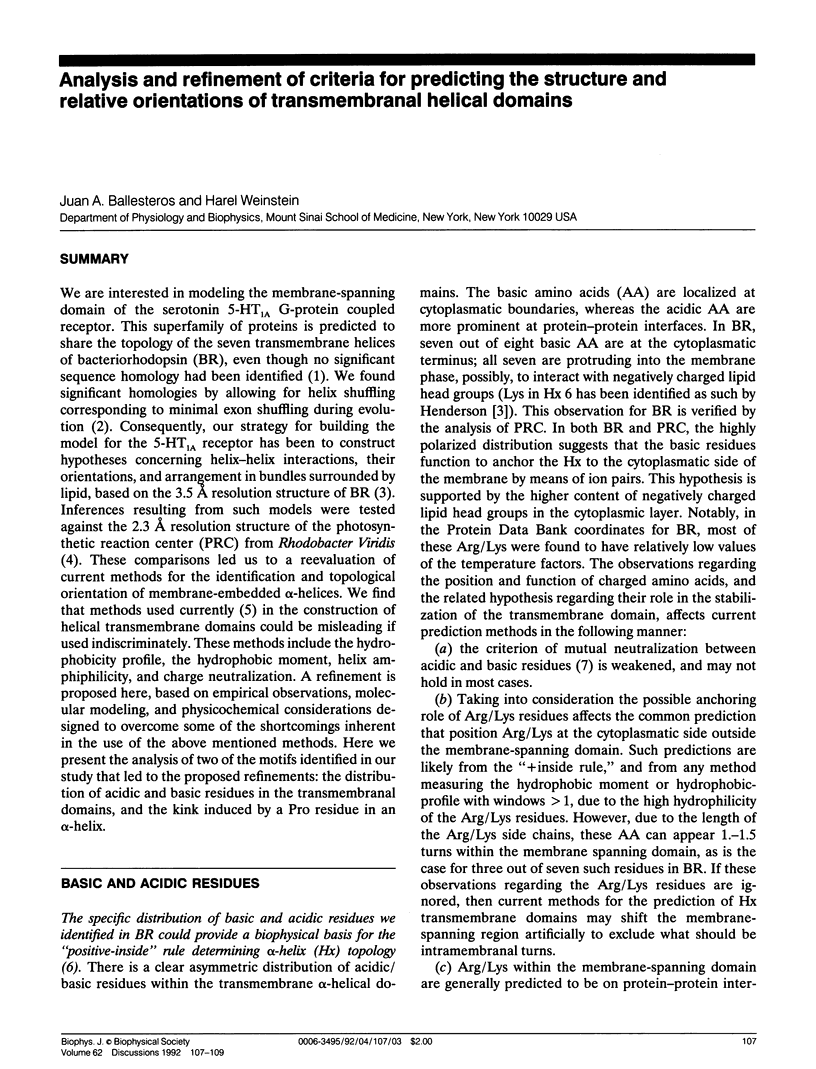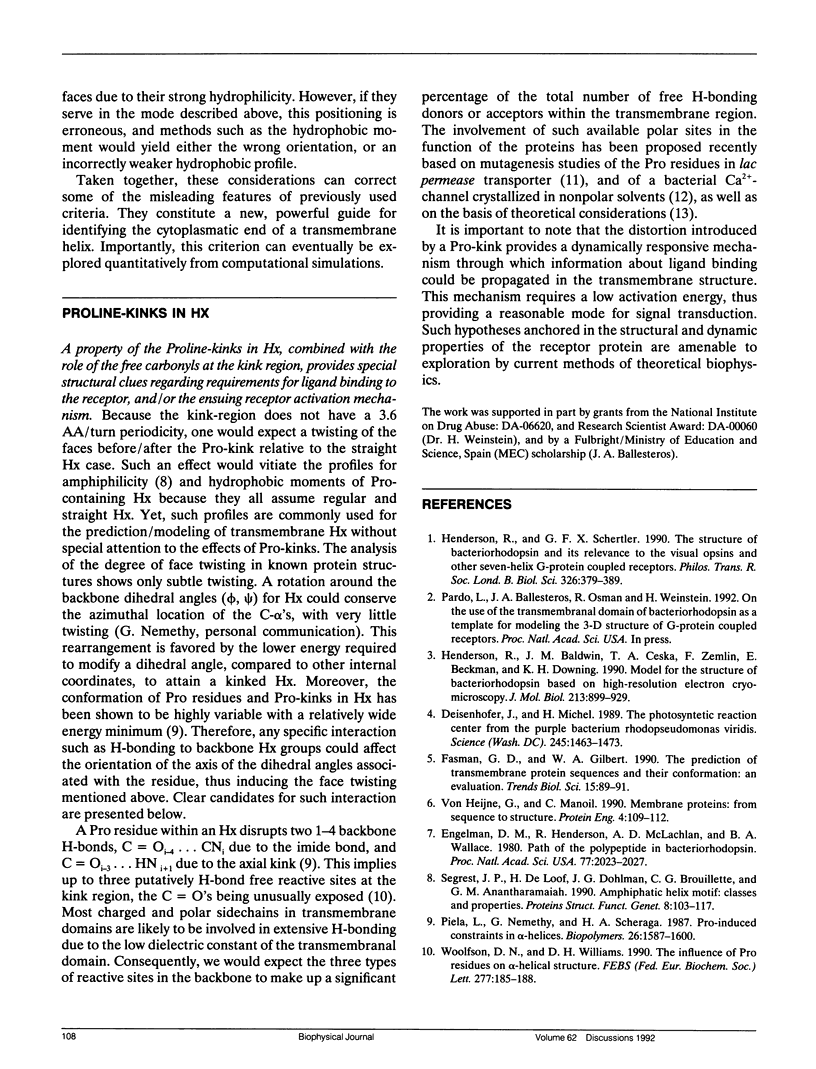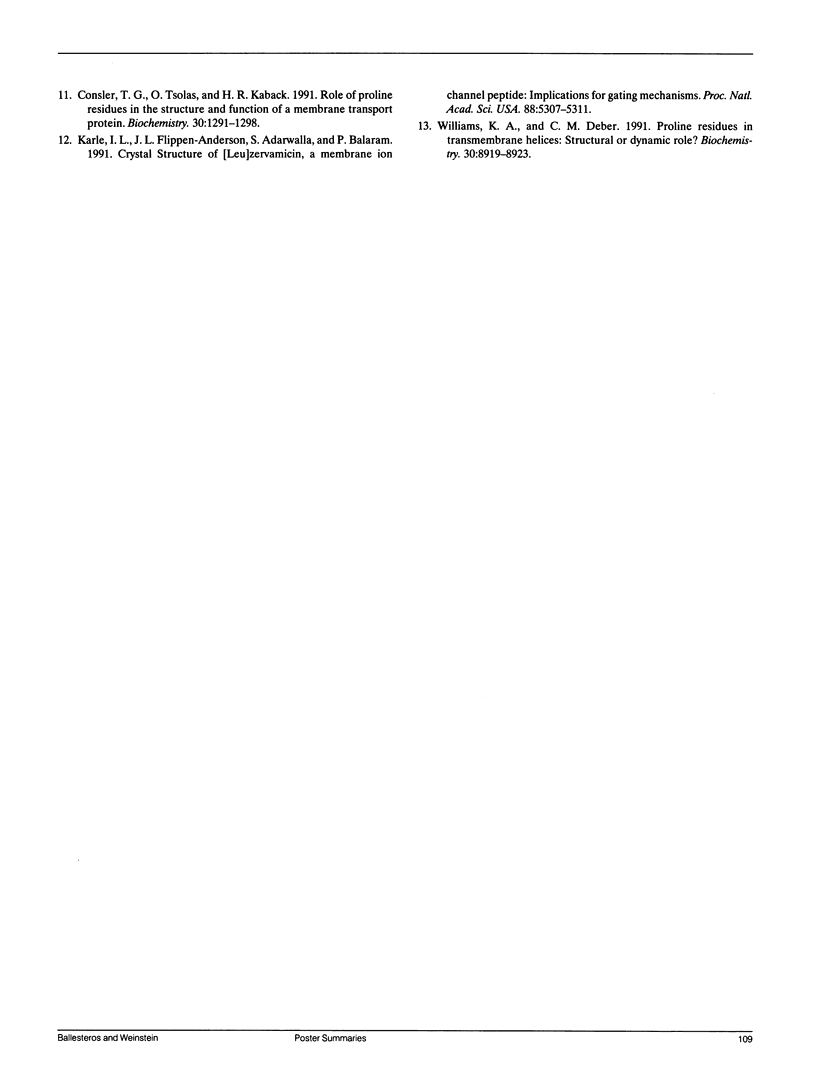Abstract
We are interested in modeling the membrane-spanning domain of the serotonin 5-HT1A G-protein coupled receptor. This superfamily of proteins is predicted to share the topology of the seven transmembrane helices of bacteriorhodopsin (BR), even though no significant sequence homology had been identified. We found significant homologies by allowing for helix shuffling corresponding to minimal exon shuffling during evolution. Consequently, our strategy for building the model for the 5-HT1A receptor has been to construct hypotheses concerning helix-helix interactions, their orientations, and arrangement in bundles surrounded by lipid, based on the 3.5 A resolution structure of BR. Inferences resulting from such models were tested against the 2.3 A resolution structure of the photosynthetic reaction center (PRC) from Rhodobacter Viridis. These comparisons led us to a reevaluation of current methods for the identification and topological orientation of membrane-embedded alpha-helices. We find that methods used currently in the construction of helical transmembrane domains could be misleading if used indiscriminately. These methods include the hydrophobicity profile, the hydrophobic moment, helix amphiphilicity, and charge neutralization. A refinement is proposed here, based on empirical observations, molecular modeling, and physicochemical considerations designed to overcome some of the shortcomings inherent in the use of the above mentioned methods. Here we present the analysis of two of the motifs identified in our study that led to the proposed refinements: the distribution of acidic and basic residues in the transmembranal domains, and the kink induced by a Pro residue in an alpha-helix.
Full text
PDF


Selected References
These references are in PubMed. This may not be the complete list of references from this article.
- Consler T. G., Tsolas O., Kaback H. R. Role of proline residues in the structure and function of a membrane transport protein. Biochemistry. 1991 Feb 5;30(5):1291–1298. doi: 10.1021/bi00219a019. [DOI] [PubMed] [Google Scholar]
- Deisenhofer J., Michel H. The Photosynthetic Reaction Center from the Purple Bacterium Rhodopseudomonas viridis. Science. 1989 Sep 29;245(4925):1463–1473. doi: 10.1126/science.245.4925.1463. [DOI] [PubMed] [Google Scholar]
- Engelman D. M., Henderson R., McLachlan A. D., Wallace B. A. Path of the polypeptide in bacteriorhodopsin. Proc Natl Acad Sci U S A. 1980 Apr;77(4):2023–2027. doi: 10.1073/pnas.77.4.2023. [DOI] [PMC free article] [PubMed] [Google Scholar]
- Fasman G. D., Gilbert W. A. The prediction of transmembrane protein sequences and their conformation: an evaluation. Trends Biochem Sci. 1990 Mar;15(3):89–92. doi: 10.1016/0968-0004(90)90187-g. [DOI] [PubMed] [Google Scholar]
- Henderson R., Baldwin J. M., Ceska T. A., Zemlin F., Beckmann E., Downing K. H. Model for the structure of bacteriorhodopsin based on high-resolution electron cryo-microscopy. J Mol Biol. 1990 Jun 20;213(4):899–929. doi: 10.1016/S0022-2836(05)80271-2. [DOI] [PubMed] [Google Scholar]
- Henderson R., Schertler G. F. The structure of bacteriorhodopsin and its relevance to the visual opsins and other seven-helix G-protein coupled receptors. Philos Trans R Soc Lond B Biol Sci. 1990 Jan 30;326(1236):379–389. doi: 10.1098/rstb.1990.0019. [DOI] [PubMed] [Google Scholar]
- Karle I. L., Flippen-Anderson J. L., Agarwalla S., Balaram P. Crystal structure of [Leu1]zervamicin, a membrane ion-channel peptide: implications for gating mechanisms. Proc Natl Acad Sci U S A. 1991 Jun 15;88(12):5307–5311. doi: 10.1073/pnas.88.12.5307. [DOI] [PMC free article] [PubMed] [Google Scholar]
- Piela L., Némethy G., Scheraga H. A. Proline-induced constraints in alpha-helices. Biopolymers. 1987 Sep;26(9):1587–1600. doi: 10.1002/bip.360260910. [DOI] [PubMed] [Google Scholar]
- Segrest J. P., De Loof H., Dohlman J. G., Brouillette C. G., Anantharamaiah G. M. Amphipathic helix motif: classes and properties. Proteins. 1990;8(2):103–117. doi: 10.1002/prot.340080202. [DOI] [PubMed] [Google Scholar]
- Williams K. A., Deber C. M. Proline residues in transmembrane helices: structural or dynamic role? Biochemistry. 1991 Sep 17;30(37):8919–8923. doi: 10.1021/bi00101a001. [DOI] [PubMed] [Google Scholar]
- Woolfson D. N., Williams D. H. The influence of proline residues on alpha-helical structure. FEBS Lett. 1990 Dec 17;277(1-2):185–188. doi: 10.1016/0014-5793(90)80839-b. [DOI] [PubMed] [Google Scholar]
- von Heijne G., Manoil C. Membrane proteins: from sequence to structure. Protein Eng. 1990 Dec;4(2):109–112. doi: 10.1093/protein/4.2.109. [DOI] [PubMed] [Google Scholar]


